Learn how to make glazed lemon blueberry scones without heavy cream or buttermilk. How do you make scones from scratch? With this easy glazed lemon blueberry scones recipe, your scones will be crispy on the outside, light and fluffy on the inside. Best of all, you can use regular milk along with a little trick to make mock buttermilk. Bonus: You can make these blueberry lemon scones without heavy cream. What can I use instead of cream in scones? I’ve got the answer. Ready to learn the secret to making this delicious glazed lemon blueberry scones recipe? Let’s get started!
Table of Contents
Glazed Lemon Blueberry Scones Backstory
Years ago, I found a basic scone recipe in the FoodDay section of The Oregonian newspaper. The recipe called for buttermilk, which I do not usually have on hand. Luckily, I had learned a trick for making faux buttermilk, and now it’s one of my favorite kitchen shortcuts. I’ll let you in on the secret further on down. You can certainly make these glazed lemon blueberry scones with buttermilk, if you have it on hand. This basic scone recipe lends itself well to many different scones flavors, like raspberry white chocolate and dark chocolate orange. This glazed lemon blueberry scone variation is a recent creation, and I hope you’ll become as big of a fan of it as I am. They are a fabulous addition to any tea party or blueberry-themed party.
Glazed Lemon Blueberry Scones Equipment
This post contains affiliate links, which means I may earn a small commission from qualifying purchases at no additional cost to you. Please read my Policies page for more information.
To make these glazed lemon blueberry scones, you will need a few kitchen items to make the process go more smoothly.
A mixing bowl and baking sheet are the basic supplies needed for this recipe. If you have a pastry blender, great, but you can also use a couple of butter knives to cut in the butter. My pastry blender is a vintage one made by Androck and is very sturdy. Here’s a heavy-duty pastry blender that is similar. A pastry blender is also terrific for quickly chopping hard-boiled eggs, as I mention in my favorite kitchen shortcuts.
Another tool that is handy to have for grating the lemon zest is a microplane zester. You can use a regular cheese grater, but a microplane zester does the job much more quickly and with less mess.
Glazed Lemon Blueberry Scones Ingredients
1 cup milk or buttermilk (if you have buttermilk, omit the lemon juice)
1 tablespoon lemon juice (bottled is fine)
3 cups flour
1/3 cup granulated sugar
2 and 1/2 teaspoons baking powder
1/2 teaspoons baking soda
1/2 teaspoon salt
3/4 cup firm butter (1 and 1/2 sticks, cut into chunks)
1 tablespoon grated lemon zest (the zest from one lemon should be enough)
1 cup of fresh or frozen blueberries (If you use frozen, try not to let them thaw out all the way.)
Ingredients for Easy Lemon Glaze for Scones
What is lemon glaze made of? Here’s an easy lemon glaze recipe that can be ready in minutes. It goes well with many different desserts.
1 cup powdered sugar
2 tablespoons lemon juice (Tip: Use the same lemon you used for grating the lemon zest.)
Glazed Lemon Blueberry Scones Instructions
To make this glazed lemon blueberry scones recipe, preheat the oven to 400 degrees. Lightly grease a baking sheet. Mix the lemon juice and the milk together to make faux buttermilk and set aside.
In a large bowl, whisk together the flour, sugar, baking powder, baking soda and salt until blended. Using a pastry blender or two butter knives, cut the butter into the flour mixture until the butter is about the size of small peas.
Hold the microplane grater over the bowl and grate in the lemon zest. Gently stir in the lemon zest and blueberries.
Make a well in the center of the butter-flour mixture and add your faux buttermilk all at once. You may stir the mixture with a fork until the dough pulls away from the side of a bowl, if you wish. Since there are so many blueberries in the mixture, I prefer to use my hands. Once the liquid has been absorbed, I turn and press the dough gently down into the bowl a few times. This gathers up all of the loose butter-flour mixture. Be careful not to squish the blueberries if you can help it.
While the dough is still in the bowl, I divide it into four parts. I shape each part into a ball and place on a lightly floured board. I use an old bread board. Lightly pat each ball into a circle.
Cut each circle into four parts and place the wedges on the prepared baking sheet.
Bake until golden, about 15 minutes. Place on a rack to cool if glazing.
Serve warm topped with lemon glaze or with homemade raspberry blueberry jam. Here are some unglazed lemon blueberry scones ready for some jam.
How to Make Lemon Glaze for Scones
Whisk the two glaze ingredients, powdered sugar and lemon juice, together in a bowl until smooth. Drizzle glaze over lemon blueberry scones with a spoon and enjoy. Top with extra lemon zest if you have any. Whenever I have to juice a lemon, I grate the lemon zest and store it in the freezer so I always have plenty of lemon zest on hand.
Tips for getting the most juice out of a lemon: First roll the lemon firmly on a countertop to help break down the cell walls and release the juice. Then, cut the lemon in half and use a citrus juicer or a reamer to extract the juice. If you don’t have a juicer or reamer, you can also squeeze the lemon halves by hand over a strainer to catch any seeds or pulp.
This glazed blueberry lemon scones recipe makes 16 regular-sized lemon blueberry scones with lemon glaze or 32 mini scones.
Glazed Blueberry Lemon Scones Variations
Meyer Lemon Blueberry Scones
To make Meyer lemon blueberry scones, just use a Meyer lemon for the zest and the juice in this recipe. Meyer lemons are smaller and rounder than regular lemons, with a thin, smooth, and orange-yellow skin. Some people prefer to use Meyer lemons in cooking and baking because they are sweeter and less acidic than regular lemons. They have a slightly floral and fragrant flavor.
Lemon Icing for Lemon Blueberry Scones
To make lemon icing instead of lemon glaze, just add a couple more ingredients and increase the amount of powdered sugar while reducing the amount of lemon juice.
Ingredients for Lemon Icing for Lemon Blueberry Scones
1/2 cup (1 stick) unsalted butter, at room temperature
2 cups powdered sugar
1 tablespoon freshly squeezed lemon juice
1/2 teaspoon vanilla extract
Directions for Lemon Icing for Lemon Blueberry Scones
In a mixing bowl, cream the butter with an electric mixer until smooth and fluffy.
Gradually add the powdered sugar to the butter, beating until well combined.
Add the lemon juice and vanilla extract to the mixture and beat until smooth.
If the mixture is too thick, gradually add heavy cream or milk until it reaches the desired consistency.
Use a spatula or knife to spread the icing onto cooled baked goods, or transfer it to a piping bag to decorate cakes and cupcakes.
Common Questions About Scones
What is the secret to making good scones?
In addition to having a great scones recipe, making good scones involves several key factors, including the ingredients, technique, and baking process. Here are some tips for making great scones:
Use cold butter: Scones are a type of pastry, and like all pastries, they require cold butter to create a flaky and tender texture. Cut the butter into small cubes and chill it in the refrigerator or freezer before incorporating it into the dry ingredients.
Don’t overwork the dough: Overworking the dough can result in tough and dry scones. Mix the ingredients together just until the dough comes together, and avoid kneading it or handling it too much.
Use the right flour: All-purpose flour is commonly used for scones, but you can also use pastry flour or cake flour for a lighter texture. Avoid using bread flour, which has a higher protein content and can make the scones too dense.
Stir in fruit and other flavorings gently: Scones can be made with a variety of flavorings, such as fruit, chocolate chips, nuts, or spices. Fold in the flavorings gently at the end of the mixing process to distribute them evenly throughout the dough.
Bake at the right temperature: Scones are typically baked at a high temperature, as in this recipe (400 degrees) to create a golden crust and a tender crumb. Be sure to preheat the oven and check the scones frequently to avoid over-browning or under-baking.
By following these tips, you can make delicious, tender, and flaky scones that are perfect for breakfast, brunch, or afternoon tea.
How do I get my scones to rise and be fluffy?
What makes scones rise best? What ingredient makes scones rise? To get your scones to rise and be fluffy, here are some tips to follow:
Use cold ingredients: Make sure that all of your ingredients, including the butter, are cold before you start making the scones. This will help the butter to stay in solid pieces, which will create pockets of steam as the scones bake and cause them to rise.
Don’t overwork the dough: Be sure to handle the dough as little as possible and only mix the ingredients until just combined. Overworking the dough can cause the gluten to develop too much, which will result in a tougher texture and less rise.
Use the right leavening agent: Baking powder is typically used in scones to help them rise. Make sure your baking powder is fresh and hasn’t expired, as this can affect the rise.
Cut the scones to the right thickness: Cut your scones to a thickness of about 1 inch to ensure that they will rise properly.
Place the scones close together on the baking sheet: Placing the scones close together on the baking sheet will help them to rise up instead of spreading out.
By following these tips, you should be able to get your scones to rise and be fluffy, with a tender crumb and a delicious flavor.
Why are my scones not light and fluffy?
If your scones are not light and fluffy, it could be due to a few reasons:
Overworking the dough: If you overwork the dough, it can cause the gluten to develop too much, resulting in a tough and dense texture. Be sure to handle the dough as little as possible and only mix the ingredients until just combined.
Using warm ingredients: If the butter, milk, or eggs are too warm, the butter can melt too quickly, and the scones won’t rise properly. Make sure all your ingredients are cold, especially the butter.
Not enough leavening: If you don’t use enough baking powder or if your baking powder is old, it won’t produce enough gas to help the scones rise. Be sure to use fresh baking powder and the correct amount according to the recipe.
Cutting the scones too thin: If the scones are cut too thin, they won’t have enough space to rise and will become dense. Cut the scones to a thickness of about 1 inch to ensure they have enough space to rise.
Baking at too low a temperature: Scones should be baked at a high temperature to help them rise quickly. If you bake them at too low a temperature, they won’t rise properly and will become dense.
Not enough fat: Scones need a good amount of fat, usually from butter, to create a tender, fluffy texture. Make sure to follow the recipe and use the correct amount of butter or fat.
By addressing these potential issues, you can adjust your scone recipe and technique to achieve a light and fluffy texture in your scones.
Should you put egg in scones?
Scones can be made with or without eggs, depending on the recipe. What does adding an egg do to scones? Including eggs in the scone dough can add richness and tenderness to the texture, as well as provide some binding properties to hold the dough together. However, some traditional scone recipes, like this one, do not include eggs.
Should you put eggs in scones? If you prefer a richer, more tender scone, you can try adding an egg to this recipe. Just keep in mind that adding an egg can also make the scones a bit denser and heavier, so you may need to adjust the other ingredients or baking time to ensure that the scones still rise properly.
What is the difference between British and American scones?
British and American scones are different in several ways, including their texture, size, and serving style. Here are some key differences:
Texture: British scones are typically lighter and crumbly, while American scones tend to be denser and more bread-like.
Size: British scones are usually smaller and more bite-sized, while American scones are larger and more substantial.
Sweetness: British scones are often less sweet than American scones, which are typically sweetened with sugar or honey.
Accompaniments: In Britain, scones are typically served with jam and clotted cream, while in America, they are often served with butter, honey, or other spreads.
Flavors: British scones tend to have classic flavors like plain, fruit, or cheese, while American scones can have a wider range of flavors like chocolate chip, pumpkin, or cinnamon.
Preparation method: British scones are often made using the rubbing-in method, where cold butter is rubbed into the flour mixture by hand to create a crumbly texture. American scones are more likely to be made using the creaming method, where the butter and sugar are beaten together to create a soft and fluffy dough.
How do I make my scones more moist?
If your scones are coming out dry or crumbly, there are a few things you can do to make them more moist and tender:
Add more liquid: One reason for dry scones could be the lack of enough moisture in the dough. Try adding a little more liquid to the dough, such as milk, cream, or yogurt, to make it more moist.
Add more fat: Adding more butter or cream can make your scones richer and more moist. However, be careful not to add too much, as it can affect the texture and cause the scones to spread or collapse.
Use sour cream: Using sour cream instead of the faux buttermilk in this scone recipe can add extra moisture and richness to the dough.
Don’t overwork the dough: Overworking the dough can cause the gluten to develop too much, resulting in a tough and dry texture. Handle the dough as little as possible and only mix the ingredients until just combined.
Bake for less time: Over-baking can also cause scones to become dry. Check your scones a few minutes before the suggested baking time and remove them from the oven as soon as they’re golden brown on top.
By adjusting these factors, you can make your scones more moist and tender, while still retaining their classic crumbly texture.
Why are my scones not flaky?
There are a few possible reasons why your scones may not be flaky:
Overworking the dough: If you knead or mix the dough too much, it can activate the gluten in the flour and cause the scones to become tough and dense, instead of flaky. Be sure to handle the dough as little as possible and mix it just until it comes together.
Not using cold ingredients: Cold butter and liquid ingredients, such as cream or milk, are essential for creating flaky layers in scones. If your ingredients are too warm, the butter will melt too quickly, and the layers won’t form. Make sure to chill your butter before using it and keep your liquid ingredients in the refrigerator until you’re ready to use them.
Using the wrong type of flour: Scones are traditionally made with all-purpose flour, which has a moderate protein content and creates a tender crumb. Using flour with too high of a protein content, such as bread flour, can result in tough and chewy scones.
By avoiding these common mistakes and following the proper techniques for making flaky scones, you should be able to achieve the light, tender texture you’re looking for.
Is buttermilk or heavy cream better for scones?
Buttermilk is acidic and has a tangy flavor that can add a subtle sourness to the scones. It also contains less fat than heavy cream, so it can create a more tender and crumbly texture in the dough. Buttermilk can be a good choice for scones with fruit or other sweet mix-ins, as it can balance out the sweetness. So for this glazed lemon blueberry scone recipe, buttermilk or faux buttermilk is the better choice.
What can I substitute for butter in scones?
Butter is a key ingredient in scone recipes, including this lemon blueberry scone recipe, as it provides flavor, richness, and helps create the tender and flaky texture that scones are known for. However, there are a few substitutes you can use if you need to avoid or replace butter in your scone recipe:
Shortening: Shortening is a popular substitute for butter in baking because it has a similar texture and consistency. It can create a flaky texture in scones and can be substituted for butter at a 1:1 ratio.
Coconut oil: Coconut oil can be used as a substitute for butter in scone recipes, especially for vegan or dairy-free versions. It has a similar texture to butter when it’s solid, but will melt at a lower temperature. Use coconut oil in its solid form and at the same quantity as the butter in the recipe.
Margarine: Margarine can be used in place of butter in scones, although it may result in a slightly different texture and flavor. Be sure to use a high-quality margarine that is formulated for baking, and use it at the same quantity as the butter in the recipe.
Sour cream or Greek yogurt: If you’re looking for a lower-fat substitute for butter, you can try using sour cream or Greek yogurt. These ingredients will provide a tangy flavor and moist texture, but won’t create the same flaky layers as butter. Use sour cream or Greek yogurt in place of half of the butter called for in the recipe.
Note that substituting butter may result in some changes to the texture and flavor of your scones, so be prepared for some experimentation to achieve your desired results.
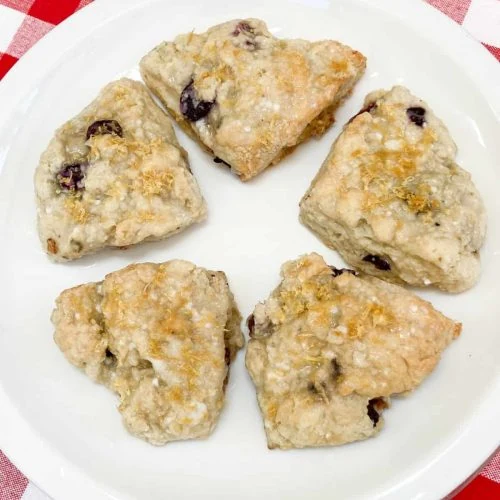
Glazed Lemon Blueberry Scones
Equipment
- 1 Large mixing bowl
- 1 Baking sheet
- 1 Pastry blender optional
- 1 Microplane zester optional
Ingredients
- 1 cup milk or buttermilk If you have buttermilk, omit the lemon juice.
- 1 tablespoon lemon juice Freshly squeezed or bottled
- 3 cups flour Regular all-purpose flour
- ⅓ cup granulated sugar
- 2½ teaspoons baking powder
- ½ teaspoon baking soda
- ½ teaspoon salt
- ¾ cup firm butter, cut into chunks 1½ sticks
- 1 tablespoon grated lemon zest The zest from one lemon should be enough
- 1 cup fresh or frozen blueberries If you use frozen, try not to let them thaw out all the way. Less mess!
Ingredients for Easy Lemon Glaze for Scones
- 1 cup powdered sugar
- 2 tablespoons lemon juice Fresh squeezed is best. You could use the same lemon you used for grating the lemon zest.
Instructions
- Preheat the oven to 400 degrees. Lightly grease a baking sheet.
- Mix the lemon juice and the milk together to make faux buttermilk and set aside.
- In a large bowl, whisk together the flour, sugar, baking powder, baking soda and salt until blended.
- Using a pastry blender or two butter knives, cut the butter into the flour mixture until the butter is about the size of small peas.
- Hold the microplane grater over the bowl and grate in the lemon zest. Stir in the lemon zest and blueberries.
- Make a well in the center of the butter-flour mixture and add your faux buttermilk all at once. You may stir the mixture with a fork until the dough pulls away from the side of a bowl, if you wish. Since there are so many blueberries in the mixture, I prefer to use my hands.
- I turn and press the dough down into the bowl a few times. This gathers up all of the loose butter-flour mixture.
- While the dough is still in the bowl, I divide it into four parts. I shape each part into a ball and place on a lightly floured board.
- Lightly pat each ball into a circle. Cut each circle into four parts and place the wedges on the prepared baking sheet.
- Bake until golden, about 15 minutes. Serve warm topped with lemon glaze or with homemade jam.
How to Make Lemon Glaze for Scones
- Whisk the two glaze ingredients, powdered sugar and lemon juice, together in a bowl until smooth.
- Drizzle glaze over lemon blueberry scones with a spoon and enjoy.
Craving Blueberry Lemon Glaze Scones?
Are freshly baked lemon-glazed blueberry scones calling your name? If you decide to try this blueberry lemon glaze scones recipe, I’d love to know how it turns out. Trying your own variation? Tag me on Instagram (lisa_fluxingwell) and I’ll mention it in my story.
Other Lemon Recipes
Are you a huge fan of lemons in recipes? Check out these fabulous lemon-themed party ideas. The list includes easy lemon recipes like lemon rosemary roasted chicken, preserved lemons, Greek lemon chicken orzo soup, and more. To satisfy your sweet tooth, make some easy lemon cookies or some lemon gelato. There are many delicious lemon-flavored possibilities. You could even host an entire lemon-themed tea party.
Other Blueberry Recipes
Perhaps you are a devotee of blueberries. I’ve got you covered there as well. Try making blueberry rhubarb coffee cake, blueberry rhubarb crisp, or a nice blueberry cobbler. If you have an air fryer, you could make some easy blueberry hand pies, which are perfect for picnics. Would you like to preserve the blueberry harvest? Can some easy blueberry lime jam, blueberry syrup, or blueberry raspberry jam. Homemade canned goods make great holiday gift ideas or party favors for guests to take home from a blueberry-themed tea party.
More Food Inspiration
Thinking of working this blueberry lemon scone recipe into your tea party or breakfast recipe collection? It’s always nice to have a plan when it comes to meals or parties. If you’re looking for a way to get more organized with your meal-planning efforts, I’ve got something for you. Free, editable meal planners! The templates can be used over and over, as often as you need them. You can make as many duplicates as you like, and you’ll be able to save old meal plans for future reference. I hope it simplifies things for you.
Get my digital, editable, printable templates!
I hope you enjoy making glazed lemon blueberry scones. May all of your baking endeavors meet with great success!
Lisa Mitchell is a wife, mom, and school librarian who likes to create and share recipes, often using fresh ingredients from her family’s small Pacific Northwest farm. For more delicious, easy recipes, click on over to the Food page.






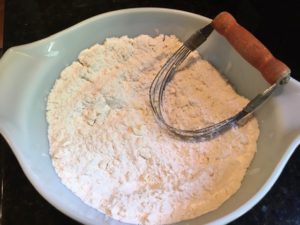


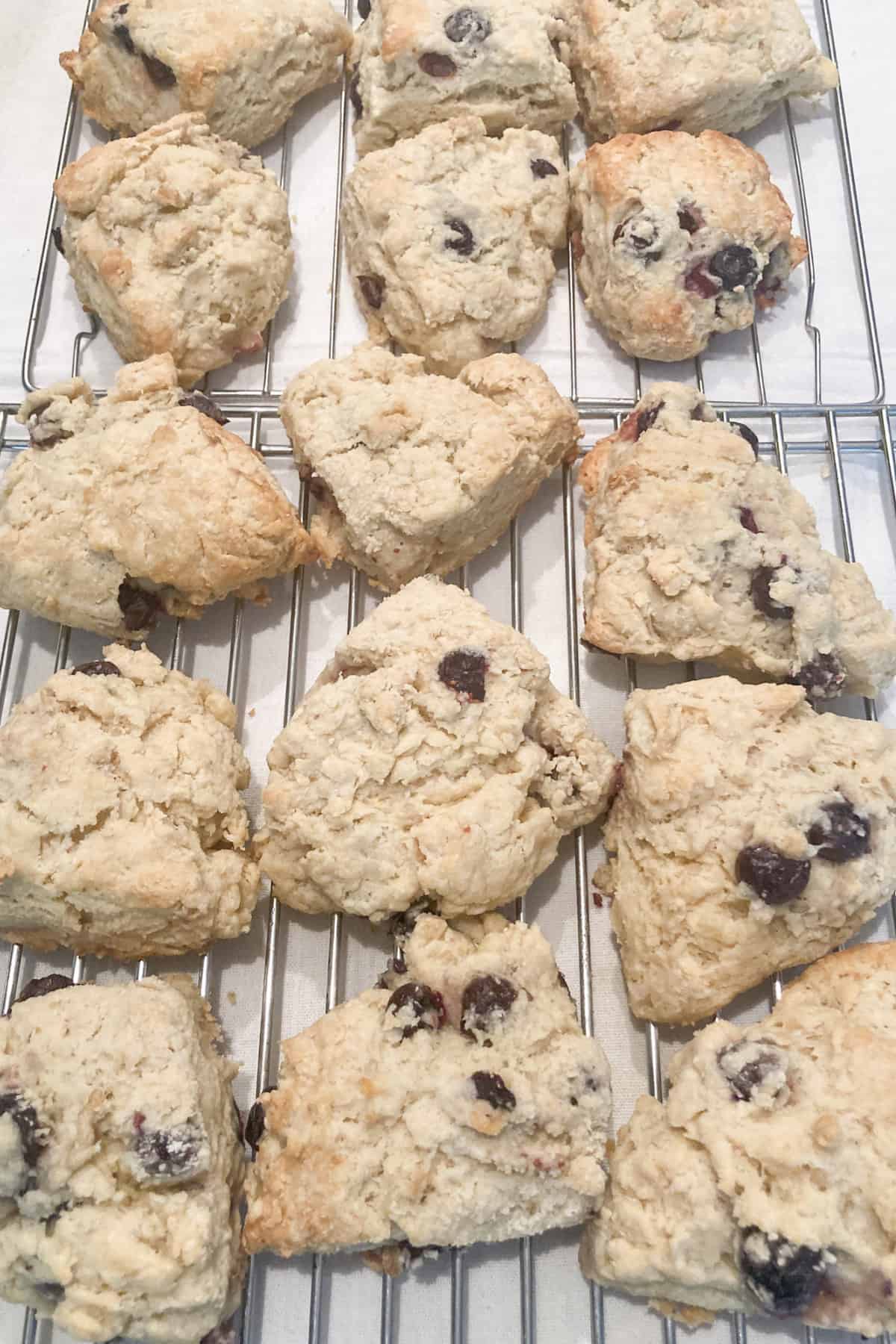


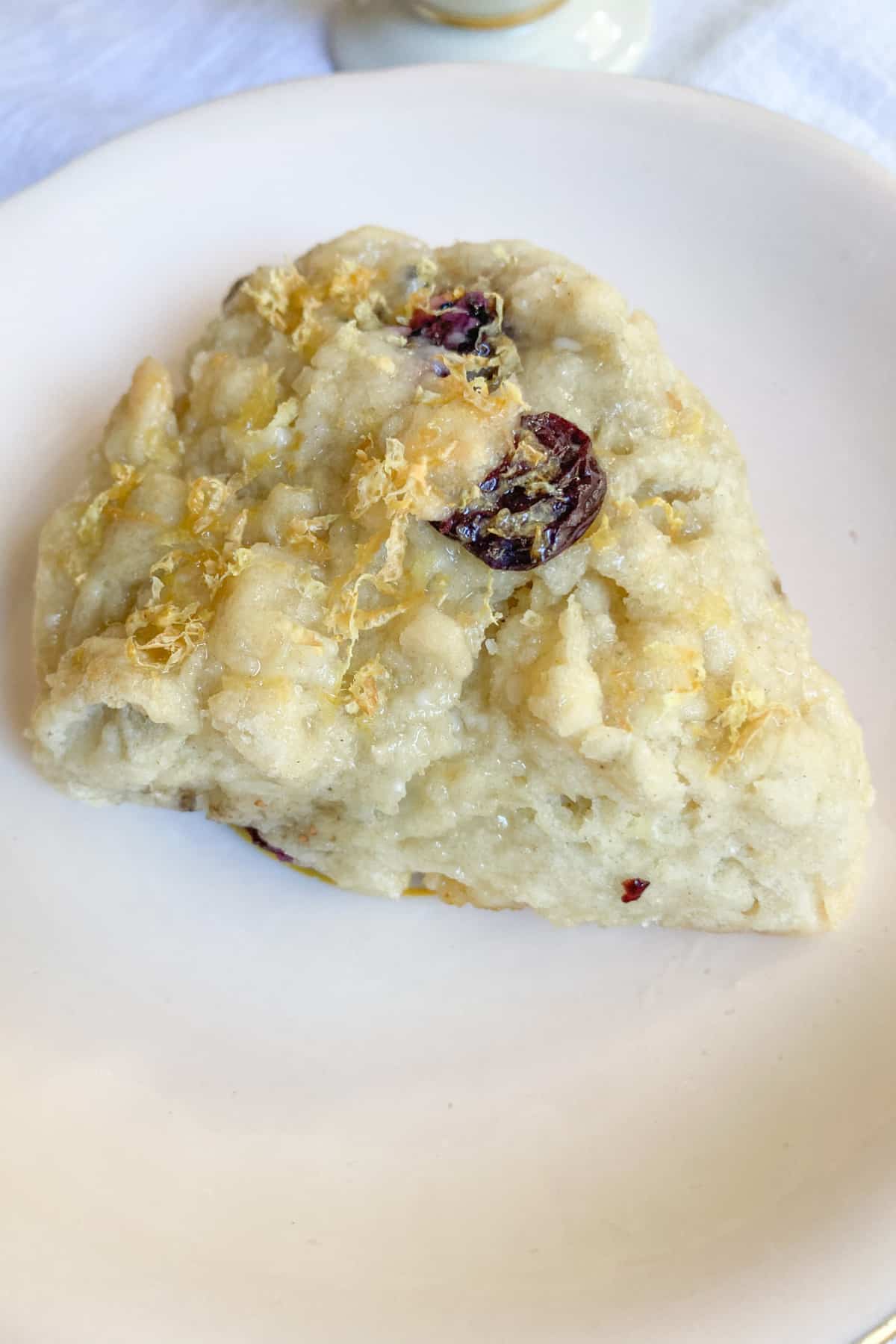
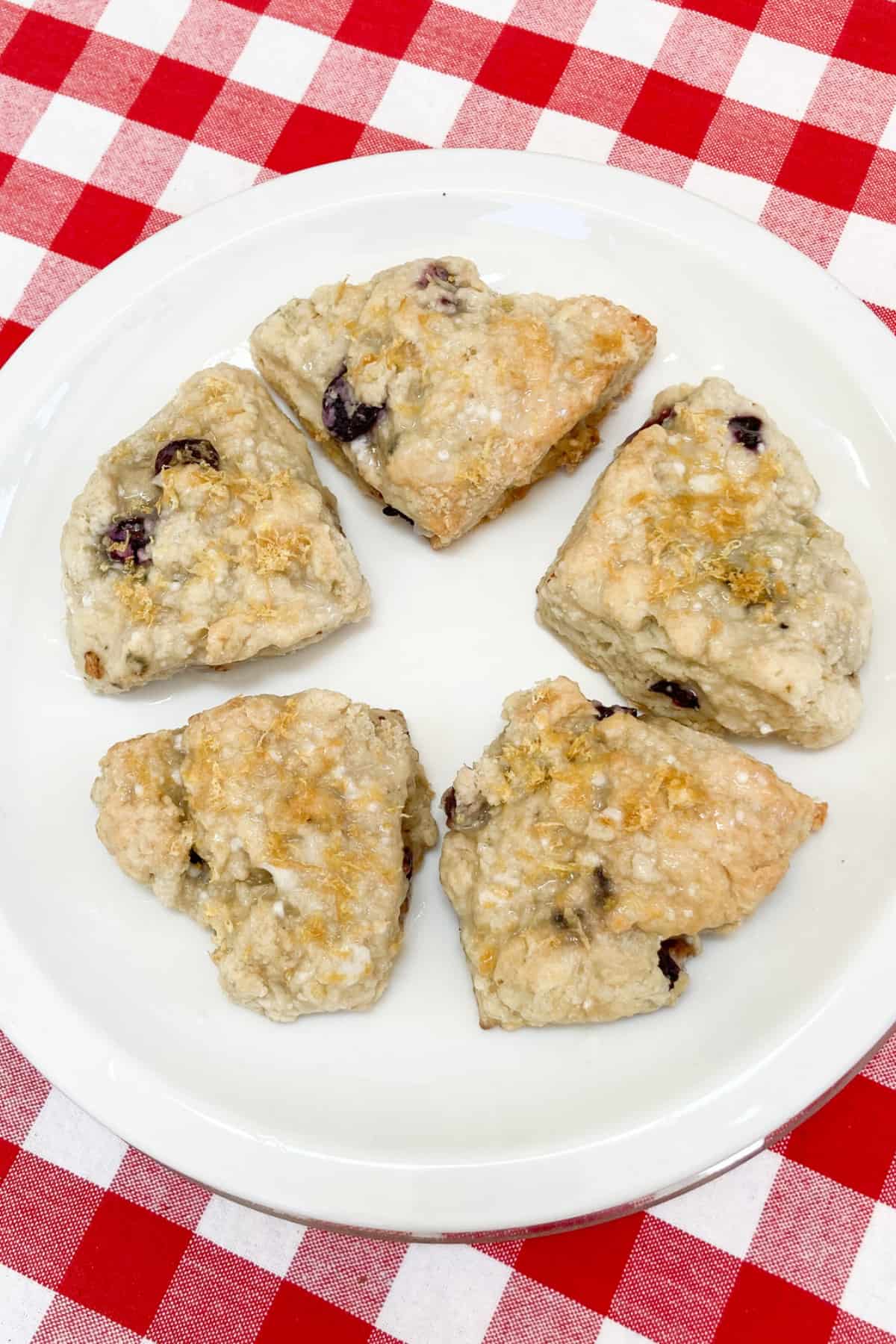

I made these, and made a few changes. First I swapped the buttermilk for 3/4 sour cream and 1/4 water. I left out the lemon zest and added 1tbsp pure vanilla extract. I topped them with some jalapeno and fig jam that my mom made, they turned out absolutely delicious!! Thank you for the recipe
You are most welcome. Wow, jalapeno and fig jam sounds amazing. So glad you liked the blueberry scones recipe!
I adore scones and these look like the best glazed lemon blueberry scones to make – especially for tea parties! We have a local restaurant that specializes in tea time and they have great scones. I’m inspired to try my hand at this recipe to make them at home!
Great! I would love to know how they turn out. How nice that you have a restaurant nearby that specializes in tea time. Fun!
I certainly am craving glazed lemon blueberry scones now after reading your recipe and all the other information. What a great combination. I absolutely love blueberries and also lemon flavors but have never thought to combine them. My grandmother use to be renown for her British style scones but back in the 1950’s they were always plain scones. I think the addition of blueberries makes them delicious and I think I will give these a go with the grandkids in the next school holidays. They always love baking as it is not something they do at home.
Terrific! What fun to make them with your grandkids. Enjoy!
Love the lemon and blueberry combination! Thanks for sharing the recipe and for the scone making tips.
You are most welcome. Making scones is fun!